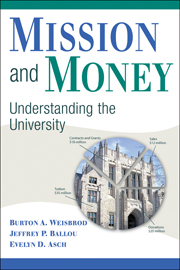Book contents
- Frontmatter
- Contents
- Illustrations
- Preface
- 1 An Introduction to the Higher Education Industry
- 2 The Higher Education Business and the Business of Higher Education – Now and Then
- 3 Is Higher Education Becoming Increasingly Competitive?
- 4 The Two-Good Framework: Revenue, Mission, and Why Colleges Do What They Do
- 5 Tuition, Price Discrimination, and Financial Aid
- 6 The Place of Donations in Funding the Higher Education Industry
- 7 Endowments and Their Management: Financing the Mission
- 8 Generating Revenue from Research and Patents
- 9 Other Ways to Generate Revenue – Wherever It May Be Found: Lobbying, the World Market, and Distance Education
- 10 Advertising, Branding, and Reputation
- 11 Are Public and Nonprofit Schools “Businesslike”? Cost-Consciousness and the Choice between Higher Cost and Lower Cost Faculty
- 12 Not Quite an Ivory Tower: Schools Compete by Collaborating
- 13 Intercollegiate Athletics: Money or Mission?
- 14 Mission or Money: What Do Colleges and Universities Want from Their Athletic Coaches and Presidents?
- 15 Concluding Remarks: What Are the Public Policy Issues?
- Appendix
- References
- Index
Preface
Published online by Cambridge University Press: 17 July 2009
- Frontmatter
- Contents
- Illustrations
- Preface
- 1 An Introduction to the Higher Education Industry
- 2 The Higher Education Business and the Business of Higher Education – Now and Then
- 3 Is Higher Education Becoming Increasingly Competitive?
- 4 The Two-Good Framework: Revenue, Mission, and Why Colleges Do What They Do
- 5 Tuition, Price Discrimination, and Financial Aid
- 6 The Place of Donations in Funding the Higher Education Industry
- 7 Endowments and Their Management: Financing the Mission
- 8 Generating Revenue from Research and Patents
- 9 Other Ways to Generate Revenue – Wherever It May Be Found: Lobbying, the World Market, and Distance Education
- 10 Advertising, Branding, and Reputation
- 11 Are Public and Nonprofit Schools “Businesslike”? Cost-Consciousness and the Choice between Higher Cost and Lower Cost Faculty
- 12 Not Quite an Ivory Tower: Schools Compete by Collaborating
- 13 Intercollegiate Athletics: Money or Mission?
- 14 Mission or Money: What Do Colleges and Universities Want from Their Athletic Coaches and Presidents?
- 15 Concluding Remarks: What Are the Public Policy Issues?
- Appendix
- References
- Index
Summary
What is vital about colleges and universities? For parents, higher educa-tion is vital to their children's lifetime careers, on one hand, but is a major financial drain on family resources, on the other. For public policy- makers, higher education is many things – a fundamental element of their constituents' demands for economic opportunity, a crucial element of the struggle for equality of access to learning and prosperity, a magnet for attracting business and industry, and a source of national, state, and local pride. But it is also a costly social service – and increasingly so. For faculty, academic administrators, and trustees, higher education is their vocation but also a business that seems increasingly driven by money alone. For researchers, higher education is an industry having much in common with other industries, consisting of thousands of competitors, each attempting to establish its own brand-name reputation, each attempting to attract contributions from public and private sources. However, it is also quite different from most other industries. Many millions have had direct experience with higher education but know little about it as an industry. Our goal is to reach all these audiences both within and outside of higher education.
We set out to understand this complex industry: how schools compete, how they finance themselves, and what social role each type of college and university plays. In the course of the research we learned a great deal. If we can convey to others some of what we learned we will have succeeded.
- Type
- Chapter
- Information
- Mission and MoneyUnderstanding the University, pp. xiii - xviPublisher: Cambridge University PressPrint publication year: 2008

